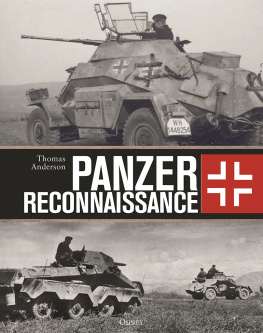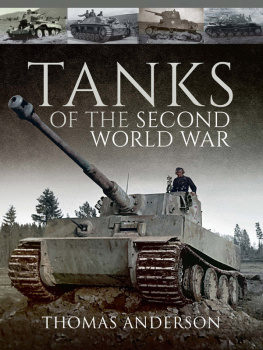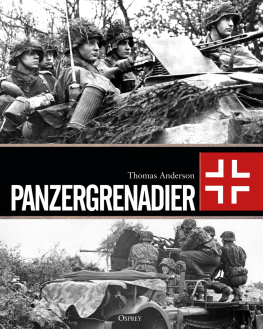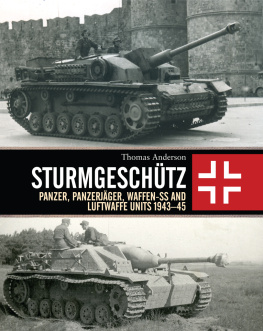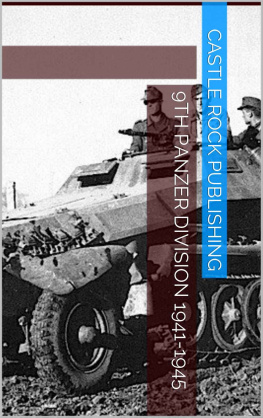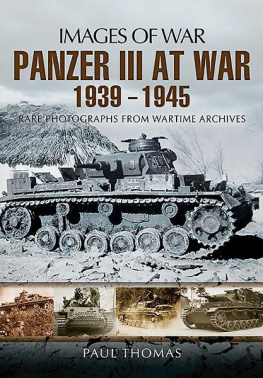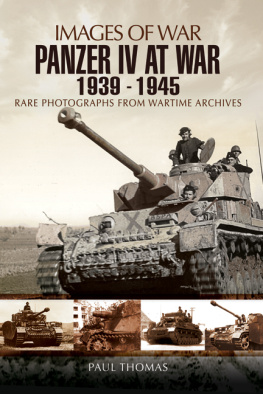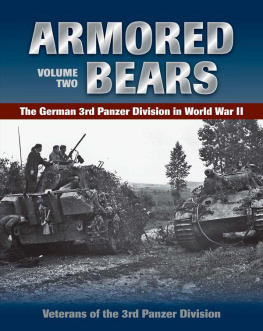Thomas Anderson - Panzer Reconnaissance
Here you can read online Thomas Anderson - Panzer Reconnaissance full text of the book (entire story) in english for free. Download pdf and epub, get meaning, cover and reviews about this ebook. year: 2023, publisher: Bloomsbury, genre: Non-fiction. Description of the work, (preface) as well as reviews are available. Best literature library LitArk.com created for fans of good reading and offers a wide selection of genres:
Romance novel
Science fiction
Adventure
Detective
Science
History
Home and family
Prose
Art
Politics
Computer
Non-fiction
Religion
Business
Children
Humor
Choose a favorite category and find really read worthwhile books. Enjoy immersion in the world of imagination, feel the emotions of the characters or learn something new for yourself, make an fascinating discovery.
- Book:Panzer Reconnaissance
- Author:
- Publisher:Bloomsbury
- Genre:
- Year:2023
- Rating:4 / 5
- Favourites:Add to favourites
- Your mark:
- 80
- 1
- 2
- 3
- 4
- 5
Panzer Reconnaissance: summary, description and annotation
We offer to read an annotation, description, summary or preface (depends on what the author of the book "Panzer Reconnaissance" wrote himself). If you haven't found the necessary information about the book — write in the comments, we will try to find it.
Panzer Reconnaissance — read online for free the complete book (whole text) full work
Below is the text of the book, divided by pages. System saving the place of the last page read, allows you to conveniently read the book "Panzer Reconnaissance" online for free, without having to search again every time where you left off. Put a bookmark, and you can go to the page where you finished reading at any time.
Font size:
Interval:
Bookmark:

PANZER RECONNAISSANCE
Thomas Anderson

A German national, Thomas Anderson is a specialist in the German armoured fighting vehicles of World War II. He has spent decades trawling through archives in the USA, Germany and the rest of Europe to discover little-known facts and previously unpublished photographs of the might of the Panzerwaffe. A modeller himself, he regularly contributes to popular modelling and historical magazines across the globe, including Military Modelcraft International (UK), Steel Art (Italy), Historia Militar (Spain) and Batailles & Blinds (France) as well as many others. He lives in a village south of Hanover.

CONTENTS

In 1936, German reconnaissance troops were initially equipped with basic Adler-built Kbelwagen (bucket seat car) which utilized the chassis of a commercial passenger car. Behind the second vehicle is a leichter Panzersphwagen (le PzSpWg light armoured car) Sonderkraftfahrzeug (SdKfz special purpose vehicle) 221.
Reconnaissance assets of all kinds have been used throughout the history of conflict to gain advantage over the enemy. Depending on its quality and relevance, this intelligence has been able to contribute decisively to decision-making at the highest echelons of military leadership. The outcomes of many engagements and battles have been significantly influenced by reconnaissance.
Military intelligence generally operates at three levels. Strategic intelligence gathers information on a global scale, using a wide variety of sources and techniques. It primarily serves the decision-making by political leaders. Operational reconnaissance covers the potential or actual battlefield and is conducted at the level of large units such as army groups or armies. It operates deep behind enemy lines. Smaller units engaged in direct combat use all the possibilities of active tactical reconnaissance. Specialized subunits are tasked with gaining knowledge about the condition and navigability of the terrain close to the front, as well as with assessing the strength and operational readiness of the enemy.
After the end of World War I, initial attempts were made in Germany to modernize their reconnaissance forces. Key companies in German industry developed wheeled armoured vehicles that were very advanced for the period, although their performance is often overestimated. After the formation of the Wehrmacht (defence force) in 1935, these modern armoured reconnaissance vehicles proved far too complex and expensive for various manufacturers to produce. The situation was exacerbated by shortages material due to a lack of raw materials.
In order to provide the newly created Panzer divisions with suitable reconnaissance elements, simple armoured cars were initially produced and introduced from 1930 onwards, abandoning almost all innovations.

Elements of a Aufklrungs-Kompanie (AufklKp reconnaissance company) at their home garrison. In the foreground are three lightly armoured Kraftfahrzeug (Kfz motor vehicle) 13 and a Kbelwagen (bucket-seat vehicle); both types were built on the same Adler chassis. Behind them are a number of SdKz 231 (6-Rad) and SdKfz 232 (6-Rad) schwerer Panzersphwagen (s PzSpWg heavy armoured cars).

The Nazi government made extensive use of lavish parades to demonstrate its military power to the German population and observers from foreign countries.
Initially development was slow. Due to the restrictions imposed under the terms of the Versailles Treaty, resources were limited and secrecy necessary. But this was soon to accelerate significantly in conjunction with the build-up of the German armoured forces. In 1937, a new generation of modern reconnaissance vehicles began to be delivered to units available: the Vierrad (4-Rad four wheel) and Achtrad (8-Rad 8-wheel) Panzersphwagen (PzSpWg armoured car).
These vehicles provided the basis for the new German reconnaissance detachments of the motorisiert (mot motorized) divisions and the Panzer divisions. During Unternehmen (Operation) Barbarossa in the Soviet Union this early equipment reached its limits and new solutions were developed and introduced. Now, half-track and tracked vehicles were deployed to fulfill the important task of ground-based reconnaissance even under the most difficult terrain conditions. At the same time, heavy weapons were introduced into the reconnaissance detachments, which significantly increased the combat power of the units, and thus their capabilities.

Initially the le PzSpWg was built in two versions: the SdKfz 223 radio vehicle, recognizable by the foldable frame-type antenna, and the SdKfz 221 armed with a 7.92mm Maschinengewehr (MG machine gun) 34.

In the 1920s, the Reichswehr began to receive a small number of wheeled personnel carriers. These unarmoured vehicles (SdKfz 3) were assigned to the newly formed Kraftfahr-Abteilungen (KfzAbt motorized battalions) and used for troops to learn the battlefield tactics to be employed by a mobile army. But, despite having all-wheel drive, the SdKfz 3 had very limited off-road performance.
As modern warfare has changed the nature of armed conflict, reconnaissance (both operational and tactical) has been given ever-increasing importance.
Essential decisions, such as the location or timing of a military operation, required good preparation. The same was true for any unit in the field exposed to the danger of a surprise and potentially devastating attack.
In the mid-1700s, Hussars came to be used as light cavalry in almost every army in Europe. Their superior speed meant that they were regularly used for reconnaissance. When led by intelligent and determined leaders, Hussars were also expected to fulfill limited combat missions, for example, disrupting enemy lines of supply or performing surprise attacks into their rear positions.
These cavalry units can, with some reservations, be considered as the forerunners of modern tactical reconnaissance. After the Napoleonic Wars, the Hussars were absorbed into a largely standardized cavalry. In many armies of Europe, the regiments were to be nominally preserved with their original names as part of maintaining tradition.
The Hussar regiments, like the Dragoon regiments, were now combat troops equipped with rifles, capable of fulfilling a wide variety of missions. In Germany, first to be assigned to infantry divisions in squadron (company) strength as dedicated reconnaissance units during the Franco-Prussian War (18701871). Even then, there was always the danger that army commanders would use the strong mobile units as mounted infantry and quickly wear them out.
Font size:
Interval:
Bookmark:
Similar books «Panzer Reconnaissance»
Look at similar books to Panzer Reconnaissance. We have selected literature similar in name and meaning in the hope of providing readers with more options to find new, interesting, not yet read works.
Discussion, reviews of the book Panzer Reconnaissance and just readers' own opinions. Leave your comments, write what you think about the work, its meaning or the main characters. Specify what exactly you liked and what you didn't like, and why you think so.

